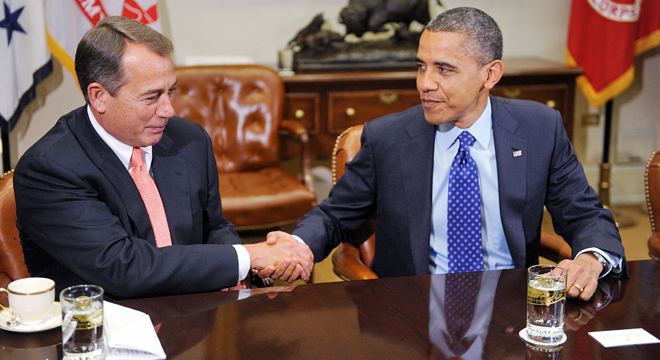Instead of negotiating among themselves to avoid the budget sequester, which will indiscriminately cut spending on federal programs starting next month, Republicans and Democrats are spending the month of February kvetching to the press about who bears responsibility for its existence.
It’s a pervasive effort by a handful of lawmakers and operatives to deflect attention from the fact that they’ve decided to allow the sequester to kick in. And for the most part, the press has done an admirable job identifying the spin war as a distraction. Party leaders agreed to it, House Republicans voted overwhelmingly for it and President Obama signed it into law — all that matters now is whether and how they address it.
But Republicans continue to pretend that White House officials bear the bulk of the responsibility for its continued existence and consequences — that by introducing the idea into debt limit negotiations back in July of 2011, they committed the only sequester sin that matters. That amounts to hoping the very people they’re spinning will forget the sorry history of that indelible crisis.
Specifically, the GOP portrays the sequester as a last-minute revision to a deal Obama and Speaker John Boehner had already agreed-upon.
“With the debt limit set to be hit in a matter of hours, Republicans and Democrats in Congress reluctantly accepted the president’s demand for the sequester, and a revised version of the Budget Control Act was passed on a bipartisan basis,” he wrote in a Wednesday Wall Street Journal op-ed.
But most of the reporting at the time, including our own, reveals the sequester was the product of days’ worth of bipartisan negotiations to create an enforcement mechanism that would assure future deficit reduction. In a way, the sequester was the least politically onerous enforcement mechanism the two parties ever considered — which goes a long way toward explaining why party leaders aren’t more urgently trying to defuse it.
The debt limit crisis began when Boehner and House Republicans created an arbitrary requirement that they would not raise the debt limit by a single dollar more than Democrats agreed to cut in federal spending over 10 years. If Democrats didn’t sign on to some plan before the country’s borrowing authority lapsed, the country might very well default on its debt.
For a time, the White House viewed the debt limit threat as an opportunity — though perhaps a kludgy and dangerous one — to reach a grand budget bargain with Boehner that included both spending cuts and new tax revenues. But when their negotiations fell apart, Obama retained only one demand: that the debt limit be increased by enough to extend the country’s borrowing authority beyond November 2012. No election-season debt limit crises. And squaring Obama’s demand with Boehner’s dollar-for-dollar rule meant that it had to be raised by a bit over $2 trillion.
The largest impediment to such a substantial increase was that Republicans continued to reject increasing taxes by even a penny. With revenue off the table, the parties could only agree to about $1 trillion in spending cuts in the form of 10-year annual caps on defense and domestic discretionary appropriations. So as soon as the grand bargain negotiations collapsed, Congressional leaders and the White House began discussing a variety of possible enforcement measures they could attach to the deal to make sure both Obama’s and Boehner’s demands were met.
Republicans floated cuts to the Affordable Care Act. Democrats proposed expiring the Bush tax cuts for income above $250,000 a year. They ultimately shelved these and other ideas. In hindsight, the struggle to find an enforcement mechanism was the first and clearest indication that neither party expected to reach a budget deal before the election. It’s why they couldn’t put their most cherished policy priorities under the guillotine.
The political appeal of the sequester was that unlike ACA cuts, or higher tax rates on the wealthy, it spread the consequences of inaction broadly and opaquely. Beyond that, the upshot for Republicans is that it allowed them to back off their default threat without transgressing against the anti-tax oath keepers in their party. Democrats, meanwhile, viewed it presciently as an opportunity to pit Republican defense hawks against the party’s radical libertarian faction, and thus break the GOP of its bad budgeting habits.
That’s why Congressional leaders agreed to it. And that’s why, as the White House is fond of reminding everyone, Boehner gloated at the time that in the debt limit deal Democrats gave him 98 percent of what he wanted.










